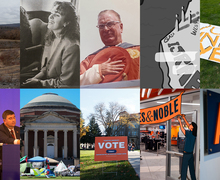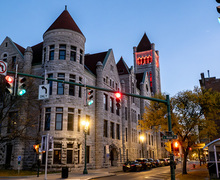Blank canvas: Art class broadens spectrum for students dabbling in painting, drawing
Editor’s note: This story is the fourth in a series appearing occasionally that is intended to give readers a glimpse into unique courses available at Syracuse University and the State University of New York College of Environmental Science and Forestry.
For the 13 students inside the cluttered studio space of Room 432, they can’t have their cake and eat it, too. They have to paint it.
A white cake topped with red frosting with a few slices around it. Small brown cupcakes with finishing touches of fluffy white frosting and sprinkles. A simple white cylinder cake.
The three desserts sit on the gray table in the middle of the room, with not only the students’ eyes upon them, but also two table lamps shining blue and red spotlights. Rebecca Aloisio, who teaches the class, moves closer to the display. She glances at the desserts and does a double take with a quizzical look.
‘Someone has eaten a cupcake,’ said Aloisio, also a graduate painting student, unleashing a loud rise of laughter from the class. The desserts, the subjects of their acrylic paintings, have been there for about a week.
The small group of students worked on this painting, inspired by pop art artist Wayne Thiebaud, for the final project required for PTG 503: ‘Drawing and Painting for Non-Majors.’ As the title suggests, the class does not require proficient level of skill sets. Each class, taking place in the Schaffer Art Building, is taught differently depending on the graduate student in charge. Aloisio, whose syllabus also includes sculpting and portraits, enjoys watching people’s styles come through each assignment.
Aloisio isn’t new to teaching. This is her second semester with this class, and she previously taught and helped high school students in Denver and Michigan get into art programs across the country. And though she envisions living off the revenue of her abstract paintings, teaching is something she doesn’t take off the table.
Outside the classroom, the fourth floor hallway in the Schaffer Art Building is a graveyard of used canvases that lean against the walls. The students work on their own, during Mondays and Wednesdays from 2:15 to 5:05 p.m.
Though Aloisio gives them a break at 3:30 p.m., she laughs and explains that they don’t take them. When break time rolls around, only one student, Amanda Imundo, leaves her area to quickly shuffle through her bag and grab a banana.
‘I’m multitasking,’ said Imundo, a junior psychology and forensic science dual major, with a smile. In one hand she holds her food and in the other a paintbrush, continuing work on a detailed half of a cake on a plate. The frosting is rendered crisp, blotched with strokes of paint.
Long moments of silence fall on the room, interrupted by students moving to re-dip paintbrushes in white and sienna, a soft brown, paint. The clinking of mugs is heard when someone cleans a paintbrush. Their eyes, fixed on the canvas, rarely falter except for brief chatter with one another and Aloisio.
Aloisio moves around the group of students encircling the display, each creating their own workspaces. Each possesses a black easel taller than them. Some insert headphones into ears and tune everything out while others converse with their neighbors once in a while. Some sit on stools, keeping their eyes level to the painting. And some stand, frequently moving away to dip their paintbrushes on the tray beside them or to stare at their work.
Clutching a sheet with paint and her paintbrush, Julissa Collado stands up on top of a cinder block that she pushed across the room. Collado, a senior communication and rhetorical studies and Spanish dual major, occasionally peers over the easel.
The last art class she took was in high school. She smoothly dips her paintbrush onto the sheet and back onto the canvas without breaking her balance. Her strokes create three diagonal pieces of cake and cupcake holders in the upper right-hand corner. She says the class is a stress reliever from schoolwork and activities in campus organizations.
‘Don’t fall,’ Aloisio says, squeezing through the space available. She passes a large whiteboard sprawling with sketches of figure drawing toward the back of the room.
Frequently talking to each student is a style of teaching her fellow graduate students dub ‘helicopter.’ She constantly peers over students’ shoulders to offer advice or answer any questions. She speaks with her hands, constantly gesturing to explain her points and motioning to stroke styles in the painting. She constantly throws around the word ‘texture,’ adding observations like: ‘This side is more shadowy’ or ‘All the frosting on this side is brighter.’
Paint is everywhere. It’s splattered on the wall above the sink where students sometimes wander to quickly wash off paintbrushes. Their backpacks rest on brown tables with big splotches. The mugs show their worn nature, their rims crusted with paint. Aloisio watches as the students work.
She says: ‘I want people to leave with something they can actually show and hang up.’
Published on April 17, 2012 at 12:00 pm
Contact Colleen: cbidwill@syr.edu





